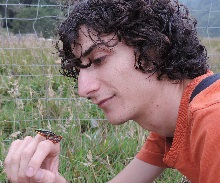Research interests
- Microbiomes / Amphibian skin microbiome
- Conservation biology
- Invasive species
- Spatial ecology
- Biostatistics
- Spatial analyses

Scientific projects
In Costa Rica (CR) many, mainly highland endemic amphibians declined and are threatened to extinction, and this has been associated to an emerging disease caused by the skin-fungal pathogen Batrachochytrium dendrobatidis (Bd). However, some species from CR seem either to be immune or recovered after a significant decline associated to Bd, and skin bacteria from some of these species has been reported to inhibit Bd-growth. This demonstrates the functional importance of specific skin bacterial communities in Bd-resistance. However, our current knowledge about amphibian skin microbiome ecology, and dynamics during Bd-infections, which could help to understand the factors that allow the survival of some amphibians, and elaborate conservation strategies with Bd-resistant bacteria to mitigate the disease, is very limited. Randall’s Ph.D. project was designed to fill this gap of knowledge by addressing relevant ‘hot’ scientific questions on animal-microbiome symbiotic interactions, host-pathogen interactions and co-evolutionary processes using two amphibian species with different Bd-infection history (Lithobates vibicarius, Isthmohyla pseudopuma) at high elevations in CR. He used high throughput sequencing approaches to investigate the potential of frogs' skin bacteria against the pathogenic chytrid fungus Batrachochytrium dendrobatidis. He also investigated the way that anthropogenic factors, habitat disturbance and pesticides, influence the frogs' skin bacteria, which could potentially impact host disease susceptibility.
After completing his PhD in January 2020 at the University of Ulm, Dr. Jiménez was awarded a postdoctoral fellowship at the Smithsonian Conservation Genomics Center of the Smithsonian Conservation Biology Institute, where he investigated the innate skin defence in Appalachian salamander species against chytrid disease, to better understand pathogen resistance and to provide information for conservation actions. Currently, Randall works at IUCN as a conservation scientist, where he supports the implementation of science team projects by developing metrics and methods for science-based biodiversity targets.
Publications
Mair L, Amorim E, Bicalho M, Brooks TM, Calfo V, Capellão RT, Clubbe C, Evju M, Fernandez EP, Ferreira GC, Hawkins F, Jiménez RR, Jordão LSB, Kyrkjeeide MO, Macfarlane NBW, Mattos BC, de Melo PHA, Monteiro LM, Lughadha EN, Pougy N, Raimondo DC, Hay Setsaas T, Shen X, de Siqueira MF, Strassburg BBN, McGowan PJK (2022) Quantifying and mapping species threat abatement opportunities to support national target setting. Conservation Biology, e14046.
Méndez-Rivera M, Mena F, Pinnock-Branford M, Ruepert C, Barquero MD, Jiménez RR, Alvarado G (2022) Effects of the insecticide β-endosulfan on tadpoles of Isthmohyla pseudopuma (Anura: Hylidae). Aquatic Toxicology, 250: 106231.
Jiménez RR, Carfagno A, Linhoff L, Gratwicke B, Woodhams DC, Soares Chafran L, Bletz MC, Bishop B, Muletz-Wolz CR (2022) Inhibitory bacterial diversity and mucosome function differentiate susceptibility of Appalachian salamanders to chytrid fungal infection. Applied and Environmental Microbiology, 88.
Whitfield SM, Alvarado-Barboza G, Abarca JG, Zumbado-Ulate H, Jimenez RR, Kerby J (2021) Ranavirus is widespread in Costa Rica and co-occurs with threatened amphibians. Diseases of Aquatic Organisms, 144:89-98.
Jiménez RR, Alvarado G, Mena F, Ruepert C, Ballestero E, Sommer S (2021) The fungicide chlorothalonil changes the amphibian skin microbiome: a potential factor disrupting a host disease-protective trait. Applied Microbiology, 1, 26–37.
https://doi.org/10.3390/applmicrobiol1010004
Jiménez RR, Alvarado G, Sandoval J, Sommer S (2020) Habitat disturbance influences the skin microbiome of a rediscovered neotropical-montane frog. BMC Microbiology, 20, 292.
Jiménez RR, Alvarado G, Estrella J, Sommer S (2019) Moving beyond the host: unravelling the skin microbiome of endangered Costa Rican amphibians. Frontiers in Microbiology (accepted 27.07.2019).
Jiménez RR, Barquero-Calvo E, Abarca JG, Porras LP (2015) Salmonella isolates in the introduced Asian house gecko (Hemidactylus frenatus) with emphasis on Salmonella Weltevreden, in houses of two regions in Costa Rica. Vector-Borne and Zoonotic Diseases 15(9): 550-555.
Jiménez RR, Rodríguez-Rodríguez JA (2015) The relationship between perch type and aggressive behavior in the lizard Norops polylepis (Polychrotidae). Phyllomedusa 14: 43–51. -- Cover Article --
Jiménez RR, Abarca JG (2015) Records of the Mourning Gecko (Lepidodactylus lugubris) and distribution in Costa Rica. Mesoamerican Herpetology 2: 214-217
Jiménez RR, Abarca JG (2014) Range extension of the Mourning Gecko (Lepidodactylus lugubris) in the Caribbean versant of Costa Rica. Herpetotropicos 10: 31-32
Whitfield SM, Geerdes E, Chacon I, Ballestero Rodriguez E, Jiménez RR, Donnelly MA, Kerby JL (2013) Infection and co-infection by the amphibian chytrid fungus and ranavirus in wild Costa Rican frogs. Diseases of Aquatic Organisms. 104: 173–178.
Touchon JC, Jiménez RR, Abinette SH, Vonesh JR, Warkentin KM (2013) Behavioral plasticity mitigates risk across environments and predators during anuran metamorphosis. Oecologia 173: 801-811. -- Cover Article --
Jiménez RR, Bolaños F (2012) Use of food and spatial resources by two frogs of the genus Dendropsophus (Hylidae), from La Selva, Costa Rica. Phyllomedusa 11(1): 51-62
Conference contributions
Jiménez RR, Abinette SH, Touchon JC, Vonesh JR, Warkentin KM (2012). Ontogeny of risk across the aquatic-terrestrial interface: how changing behavior and morphology affect predation through anuran metamorphosis. Society for Integrative and Comparative Biology Meetings, Charleston, South Carolina, USA.
Contact
- Dr. Randall Jiménez
Email: randall87()gmail.com
